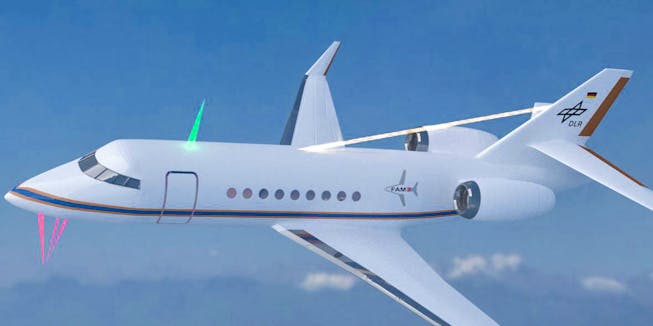New measuring systems
Lasers to improve aircraft safety
Flight altitude and speed have been measured mechanically since the beginning of aviation. Lasers would be more reliable. German researchers are now testing this method.

Laser-based sensor systems can avoid ice, dirt and airflow disturbances.

Laser-based sensor systems can avoid ice, dirt and airflow disturbances.
An aeroplane shooting out laser beams sounds like a science fiction movie. But that is exactly what the German Aerospace Center (DLR) is planning in real life. In 2022, the research institute wants to carry out flight tests with highly bundled light beams as sensors for flight data.
Many of the sensors used by aircraft to determine speed, altitude or climb and descent rates work mechanically. This has been the case since the very beginning of aviation, DLR explains. With the project Fame – the abbreviation stands for Future Air Data System Module Evaluation – the researchers want to make the collection of relevant flight data more reliable.
Critical components
Current measuring equipment sticks out of the aircraft fuselage, thus influencing the air flow. According to DLR, this can have an impact on the quality of the measured values. «Previous probes and sensors can also become dirty or iced up. The measured values can therefore become less accurate», explains DLR researcher Oliver Kliebisch. He specialises in solid-state lasers and non-linear optics.
«You don’t necessarily notice that right away in the cockpit», says Kliebisch. In times of highly automated flight control systems, feeding in inaccurate data can have fatal consequences. The crash of an Airbus A330 of Air France on flight AF447 in 2009 was caused by pilot error, for example, after contradictory speed data due to iced pitot tubes caused the autopilot to switch off.
«Up to a thousand measurements per second»
During the crashes of two Boeing 737 Max in Indonesia and Ethiopia, the so-called angle of attack (AoA) sensors, which are using airflow, played a role. After these provided incorrect data, the faulty flight control software MCAS caused the aircraft to enter an unstoppable nosedive. The use of lasers is supposed to provide more reliability, and light beams cannot ice up or get dirty.
Nor do they disturb aerodynamics. With the so-called «Optical Air Data», systems study the interaction of laser and air molecules. «Depending on the method used, we carry out up to a thousand measurements per second at a distance of up to one metre from the aircraft body», says Kliebisch.
Possible use against turbulence
With a total of three different measuring methods, conclusions can be drawn about relative wind speed, temperature and pressure. In other words, those flight parameters which are used in today’s cockpit systems to calculate airspeed and altitude. According to Kliebisch, another advantage of lasers is that they can be calibrated with relatively little effort.
«Optical Air Data has the potential to supplement or replace classic sensor technology» Kliebisch suggests. The researcher also sees opportunities for lasers in aviation elsewhere. Recent advances in the development of so-called fibre lasers, a high-power variant, could make it possible to develop systems for detecting turbulence.
Robust and compact
For the time being, DLR’s Fame project is concentrating on the planned test flight campaign in 2022. All the necessary technologies have already been developed in the laboratory and are being further refined. At present, robust and compact designs for the laser systems are being developed in order to prepare them for use on the outside of a test aircraft.
